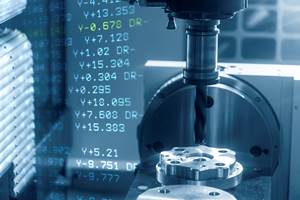Control Helps Museum Fill In The Gaps
Today, with Hollywood leading the way in the precise, high tech creation of real and imaginary forms, anything seems possible, such as bionic people, dinosaurs or extra-terrestrial beings. But the final machining of the prototypes, molds and net shapes of these forms is still being done the 'old-fashioned' way with lathes, mills, grinders and routers.
Share






In the past, when the Field Museum of Natural History in Chicago was short a few bones, it would take what it had—perhaps a dinosaur's right humerus—and find somebody who would actually carve or sculpt a left humerus. The museum got its bone, but often the result was not as accurate as it could be.
Today, with Hollywood leading the way in the precise, high tech creation of real and imaginary forms, anything seems possible, such as bionic people, dinosaurs or extra-terrestrial beings. But the final machining of the prototypes, molds and net shapes of these forms is still being done the "old-fashioned" way with lathes, mills, grinders and routers.
So in 1997 when the Field Museum acquired Sue, a 67 million-year-old fossil and the world's largest, most complete and best preserved Tyrannosaurus Rex ever found, the museum looked to a rapid prototyping shop to fill in some missing bones. The bones ranged from tiny 4- or 5-inch forearm and toe bones to 5-foot long ribs and leg bones.
The Field Museum was referred to Satellite Models (Belmont, California) for help, and Kelly Hand answered the call. Satellite does sculpture enlargement, museum exhibits, architectural patterns and litigation models. Its technique is based on the use of a 3D CAD program that allows Mr. Hand to create mirror images (or resizing) of the scans. Satellite then uses a five-axis CNC router to cut the mirror image replica of Sue's bones. Tom Corlett Jr., owner of, Quintax Inc. (Canton, Ohio), supplied the CNC router to Satellite, and he chose a Fagor Automation (Elk Grove Village, Illinois) 8055B control to make the cutting process as accurate as possible.
Satellite Models uses a postprocessor program to convert the coordinates from Mr. Hand's scan to G code, and the Fagor 8055B control directs the five-axis CNC router to make the bones. Each bone needed to be machined in as many as four to six different directions to get in all its detail. Then the Field Museum made molds of the prototypes and cast the bones in a resin that is typically used for museum dinosaur bones.
"I can quickly go from the STL (file) to generating tool paths," Mr. Hand says. "Then I can scale it, mirror image it or do whatever my client wants. From this I generate a tool path for my five-axis Quintax with the Fagor control on it. I mill these models out of whatever material is appropriate—from lightweight urethane foam and EPS foam to some of the more rigid modeling boards that are out there."
Mr. Hand's file sizes typically range from 2 to 3 MB up to 20 MB of G-code files. He can handle these file sizes because the Fagor control has a 32-bit CPU with math co-processor and 1 MB of RAM. It's equipped with 4 MB of memory for programs and PLC but can take two memory cards up to 24 MB each. It also has a 2 GB hard disk with an ethernet option.
Why did Quintax (the manufacturer of Satellite Model's five-axis router) decide that Fagor controls could meet the needs of high tech prototyping shops? Mr. Corlett explains, "We found that the ‘upper end' controls really didn't offer all that much more in terms of capability compared to what Fagor has. I'd have to say that Fagor gave us a fairly powerful control at a reasonable price. But what's even more important, Fagor has been willing to listen to us. They've been very open in helping to develop the control along the lines that we would like to see it developed, and they've accommodated us on features for high speed machining. They've also developed certain features such as tool length sensing, probing and other proprietary features for our machines in addition to customizing the software."
Related Content
5 Reasons Why You Should Know How to Write Custom Macros
Custom macros enhance what can be done in G-code programs, giving users the ability to code operations that were previously not possible.
Read MoreCan AI Replace Programmers? Writers Face a Similar Question
The answer is the same in both cases. Artificial intelligence performs sophisticated tasks, but falls short of delivering on the fullness of what the work entails.
Read MoreSetting Up the Building Blocks for a Digital Factory
Woodward Inc. spent over a year developing an API to connect machines to its digital factory. Caron Engineering’s MiConnect has cut most of this process while also granting the shop greater access to machine information.
Read MoreTips for Designing CNC Programs That Help Operators
The way a G-code program is formatted directly affects the productivity of the CNC people who use them. Design CNC programs that make CNC setup people and operators’ jobs easier.
Read MoreRead Next
AMRs Are Moving Into Manufacturing: 4 Considerations for Implementation
AMRs can provide a flexible, easy-to-use automation platform so long as manufacturers choose a suitable task and prepare their facilities.
Read MoreMachine Shop MBA
Making Chips and 91ÊÓƵÍøÕ¾ÎÛ are teaming up for a new podcast series called Machine Shop MBA—designed to help manufacturers measure their success against the industry’s best. Through the lens of the Top Shops benchmarking program, the series explores the KPIs that set high-performing shops apart, from machine utilization and first-pass yield to employee engagement and revenue per employee.
Read MoreLast Chance! 2025 Top Shops Benchmarking Survey Still Open Through April 30
Don’t miss out! 91ÊÓƵÍøÕ¾ÎÛ's Top Shops Benchmarking Survey is still open — but not for long. This is your last chance to a receive free, customized benchmarking report that includes actionable feedback across several shopfloor and business metrics.
Read More





















